Abstract
Erwinia spp. are gram-negative facultative anaerobes within the family Enterobacteriacae which possess several desirable traits for the conversion of pentose sugars to ethanol, such as the ability to ferment a broad range of carbohydrates and the ease with which they can be genetically modified. Twenty-eight strains of Erwinia carotovora and E. chrysanthemi were screened for the ability to ferment d-xylose to ethanol. E. chrysanthemi B374 was chosen for further study on the basis of its superior (4%) ethanol tolerance. We have characterized the fermentation of d-xylose and l-arabinose by the wild type and mutants which bear plasmids containing the pyruvate decarboxylase gene from Zymomonas mobilis. Expression of the gene markedly increased the yields of ethanol (from 0.7 up to 1.45 mol/mol of xylose) and decreased the yields of formate, acetate, and lactate. However, the cells with pyruvate decarboxylase grew only one-fourth as fast as the wild type and tolerated only 2% ethanol. Alcohol tolerance was stimulated by the addition of yeast extract to the growth medium. Xylose catabolism was characterized by a high saturation constant Ks (4.5 mM).
Full text
PDF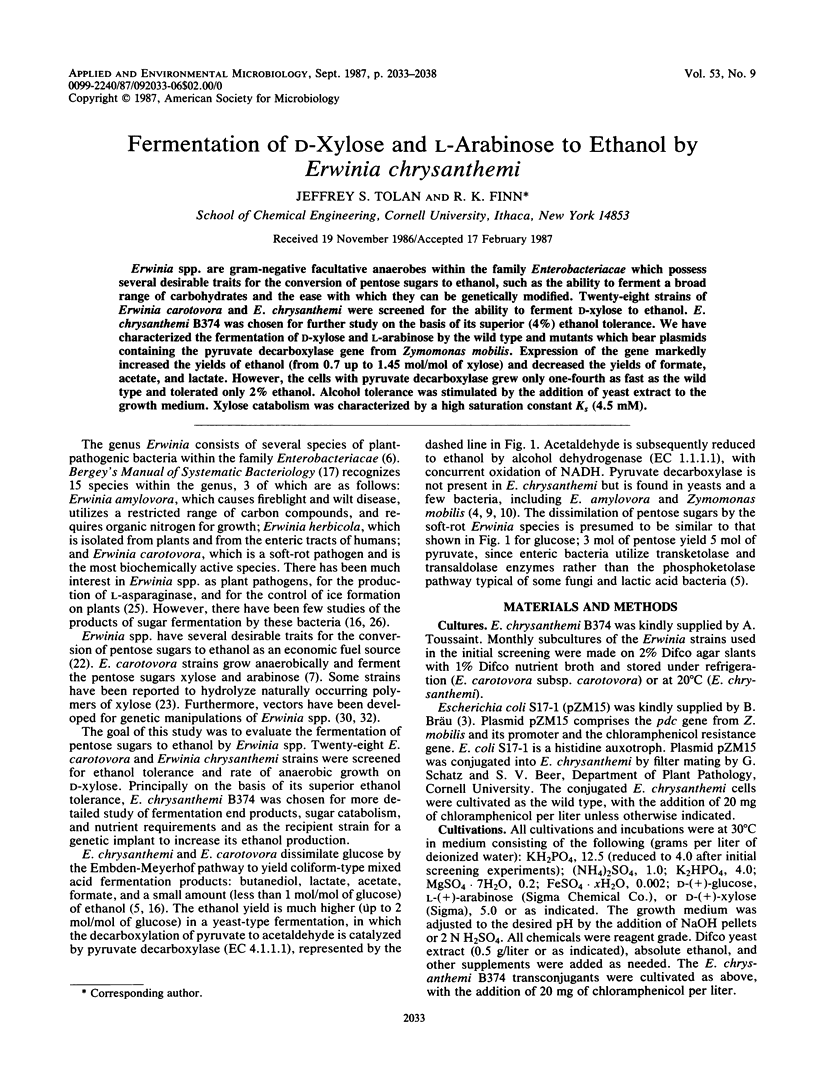
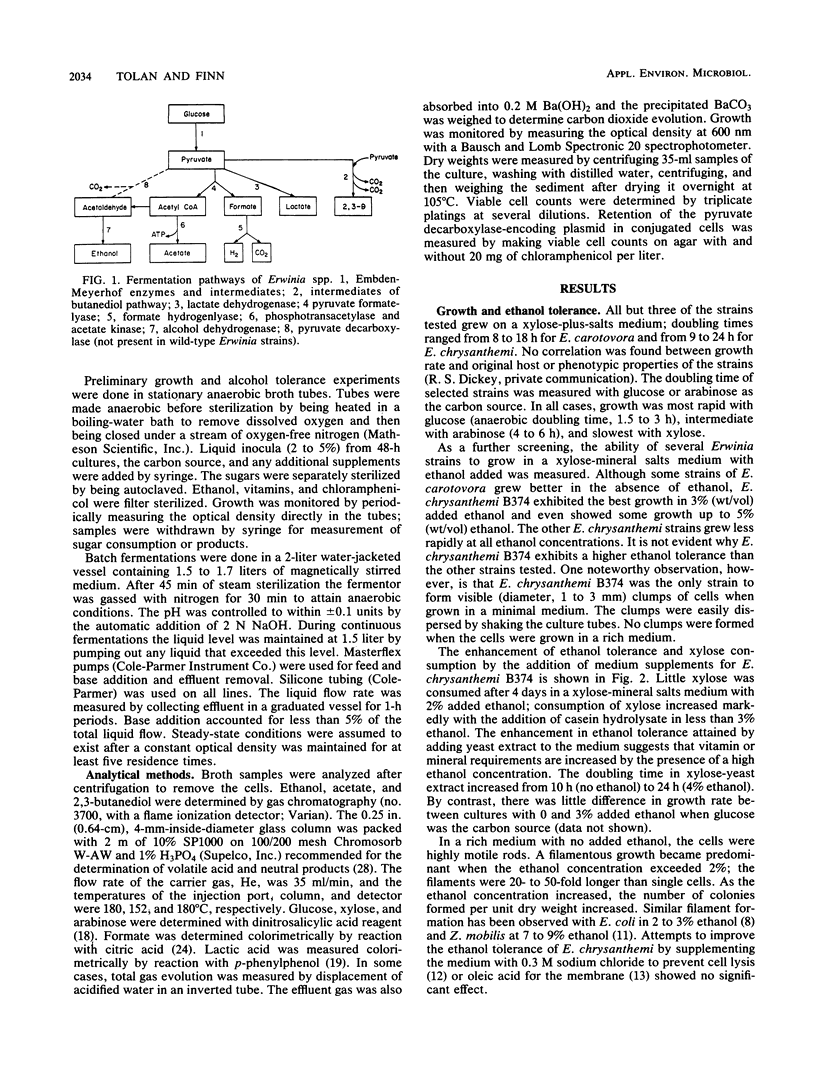
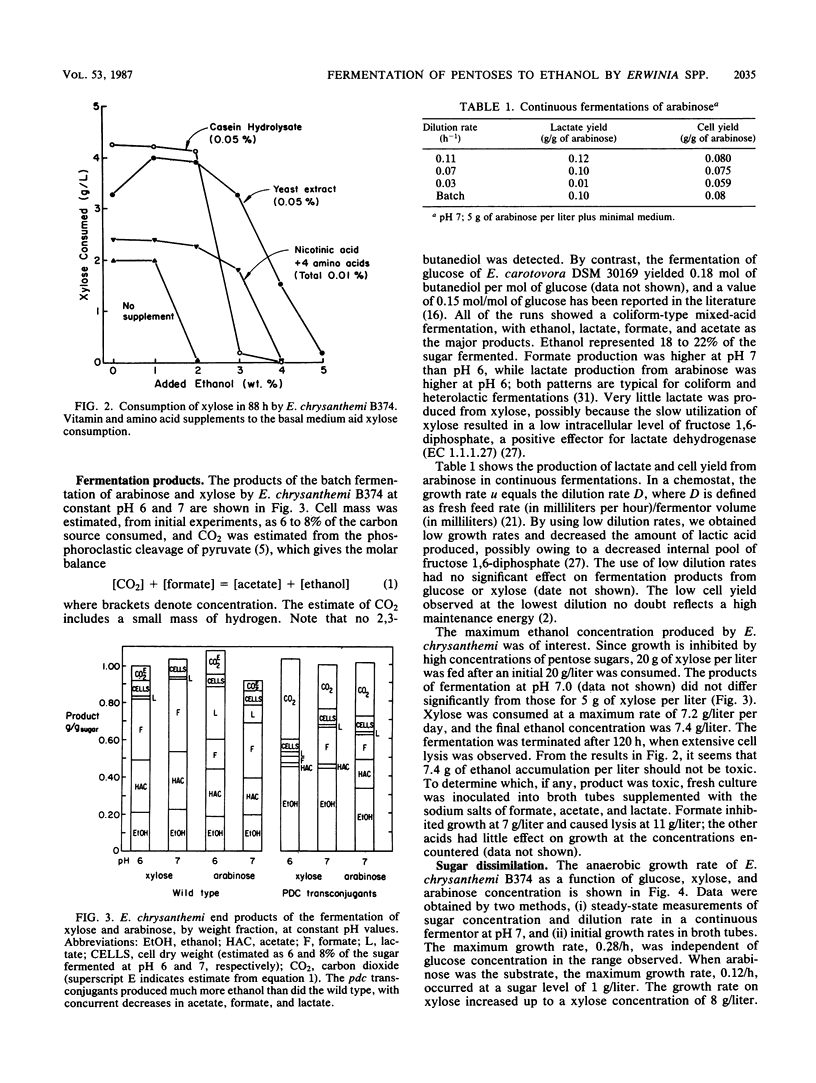
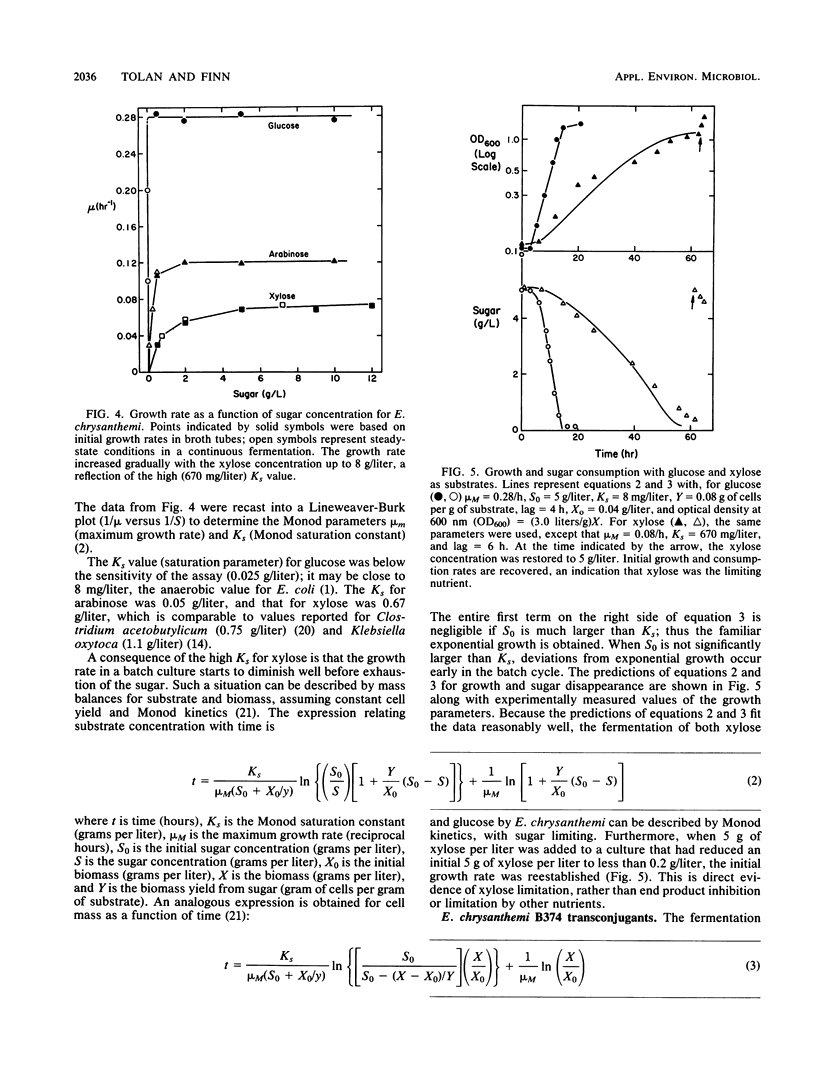
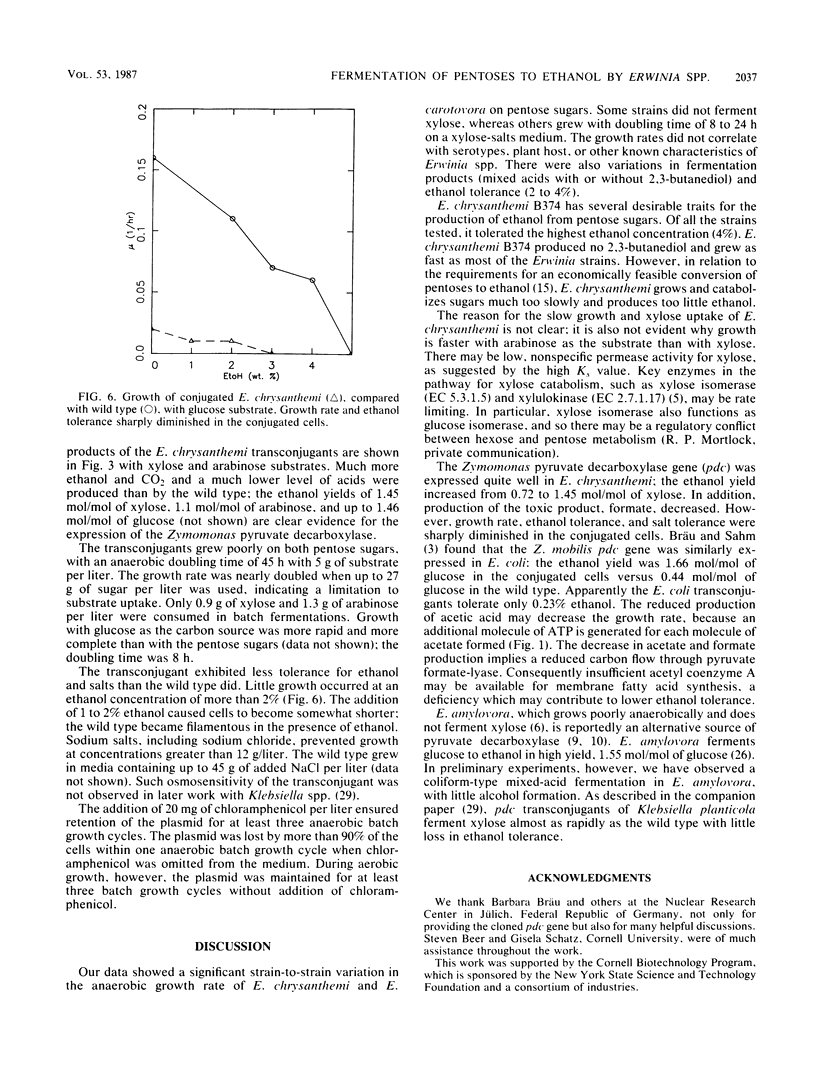
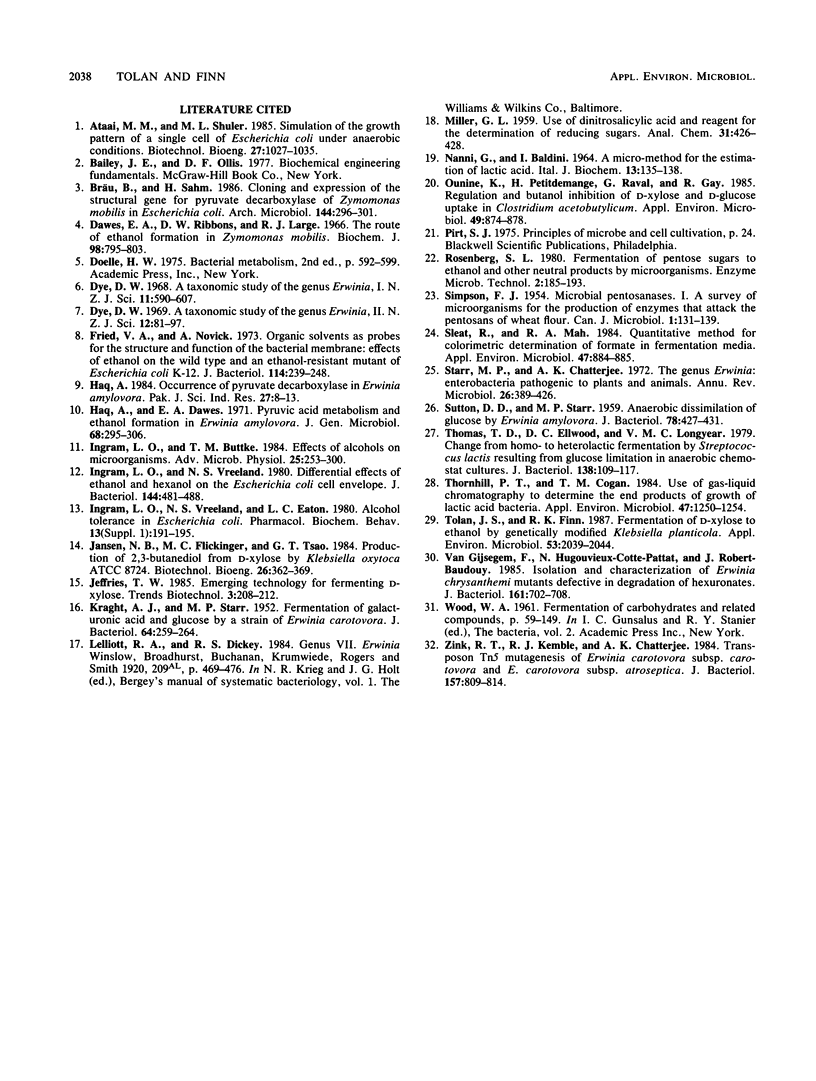
Selected References
These references are in PubMed. This may not be the complete list of references from this article.
- Dawes E. A., Ribbons D. W., Large P. J. The route of ethanol formation in Zymomonas mobilis. Biochem J. 1966 Mar;98(3):795–803. doi: 10.1042/bj0980795. [DOI] [PMC free article] [PubMed] [Google Scholar]
- Fried V. A., Novick A. Organic solvents as probes for the structure and function of the bacterial membrane: effects of ethanol on the wild type and an ethanol-resistant mutant of Escherichia coli K-12. J Bacteriol. 1973 Apr;114(1):239–248. doi: 10.1128/jb.114.1.239-248.1973. [DOI] [PMC free article] [PubMed] [Google Scholar]
- Haq A., Dawes E. A. Pyruvic acid metabolism and ethanol formation in Erwinia amylovora. J Gen Microbiol. 1971 Nov;68(3):295–306. doi: 10.1099/00221287-68-3-295. [DOI] [PubMed] [Google Scholar]
- Ingram L. O., Buttke T. M. Effects of alcohols on micro-organisms. Adv Microb Physiol. 1984;25:253–300. doi: 10.1016/s0065-2911(08)60294-5. [DOI] [PubMed] [Google Scholar]
- Ingram L. O., Vreeland N. S. Differential effects of ethanol and hexanol on the Escherichia coli cell envelope. J Bacteriol. 1980 Nov;144(2):481–488. doi: 10.1128/jb.144.2.481-488.1980. [DOI] [PMC free article] [PubMed] [Google Scholar]
- Ingram L. O., Vreeland N. S., Eaton L. C. Alcohol tolerance in Escherichia coli. Pharmacol Biochem Behav. 1980;13 (Suppl 1):191–195. doi: 10.1016/s0091-3057(80)80030-x. [DOI] [PubMed] [Google Scholar]
- KRAGHT A. J., STARR M. P. Fermentation of galacturonic acid and glucose by a strain of erwinia carotovora. J Bacteriol. 1952 Aug;64(2):259–264. doi: 10.1128/jb.64.2.259-264.1952. [DOI] [PMC free article] [PubMed] [Google Scholar]
- Ounine K., Petitdemange H., Raval G., Gay R. Regulation and butanol inhibition of D-xylose and D-glucose uptake in Clostridium acetobutylicum. Appl Environ Microbiol. 1985 Apr;49(4):874–878. doi: 10.1128/aem.49.4.874-878.1985. [DOI] [PMC free article] [PubMed] [Google Scholar]
- SIMPSON F. J. Microbial pentosanases. I. A survey of microorganisms for the production of enzymes that attack the pentosans of wheat flour. Can J Microbiol. 1954 Oct;1(2):131–139. doi: 10.1139/m55-017. [DOI] [PubMed] [Google Scholar]
- SUTTON D. D., STARR M. P. Anaerobic dissimilation of glucose by Erwinia amylovora. J Bacteriol. 1959 Sep;78:427–431. doi: 10.1128/jb.78.3.427-431.1959. [DOI] [PMC free article] [PubMed] [Google Scholar]
- Sleat R., Mah R. A. Quantitative method for colorimetric determination of formate in fermentation media. Appl Environ Microbiol. 1984 Apr;47(4):884–885. doi: 10.1128/aem.47.4.884-885.1984. [DOI] [PMC free article] [PubMed] [Google Scholar]
- Starr M. P., Chatterjee A. K. The genus Erwinia: enterobacteria pathogenic to plants and animals. Annu Rev Microbiol. 1972;26:389–426. doi: 10.1146/annurev.mi.26.100172.002133. [DOI] [PubMed] [Google Scholar]
- Thomas T. D., Ellwood D. C., Longyear V. M. Change from homo- to heterolactic fermentation by Streptococcus lactis resulting from glucose limitation in anaerobic chemostat cultures. J Bacteriol. 1979 Apr;138(1):109–117. doi: 10.1128/jb.138.1.109-117.1979. [DOI] [PMC free article] [PubMed] [Google Scholar]
- Thornhill P. J., Cogan T. M. Use of gas-liquid chromatography to determine the end products of growth of lactic Acid bacteria. Appl Environ Microbiol. 1984 Jun;47(6):1250–1254. doi: 10.1128/aem.47.6.1250-1254.1984. [DOI] [PMC free article] [PubMed] [Google Scholar]
- Tolan J. S., Finn R. K. Fermentation of d-Xylose to Ethanol by Genetically Modified Klebsiella planticola. Appl Environ Microbiol. 1987 Sep;53(9):2039–2044. doi: 10.1128/aem.53.9.2039-2044.1987. [DOI] [PMC free article] [PubMed] [Google Scholar]
- Zink R. T., Kemble R. J., Chatterjee A. K. Transposon Tn5 mutagenesis in Erwinia carotovora subsp. carotovora and E. carotovora subsp. atroseptica. J Bacteriol. 1984 Mar;157(3):809–814. doi: 10.1128/jb.157.3.809-814.1984. [DOI] [PMC free article] [PubMed] [Google Scholar]
- van Gijsegem F., Hugouvieux-Cotte-Pattat N., Robert-Baudouy J. Isolation and characterization of Erwinia chrysanthemi mutants defective in degradation of hexuronates. J Bacteriol. 1985 Feb;161(2):702–708. doi: 10.1128/jb.161.2.702-708.1985. [DOI] [PMC free article] [PubMed] [Google Scholar]


